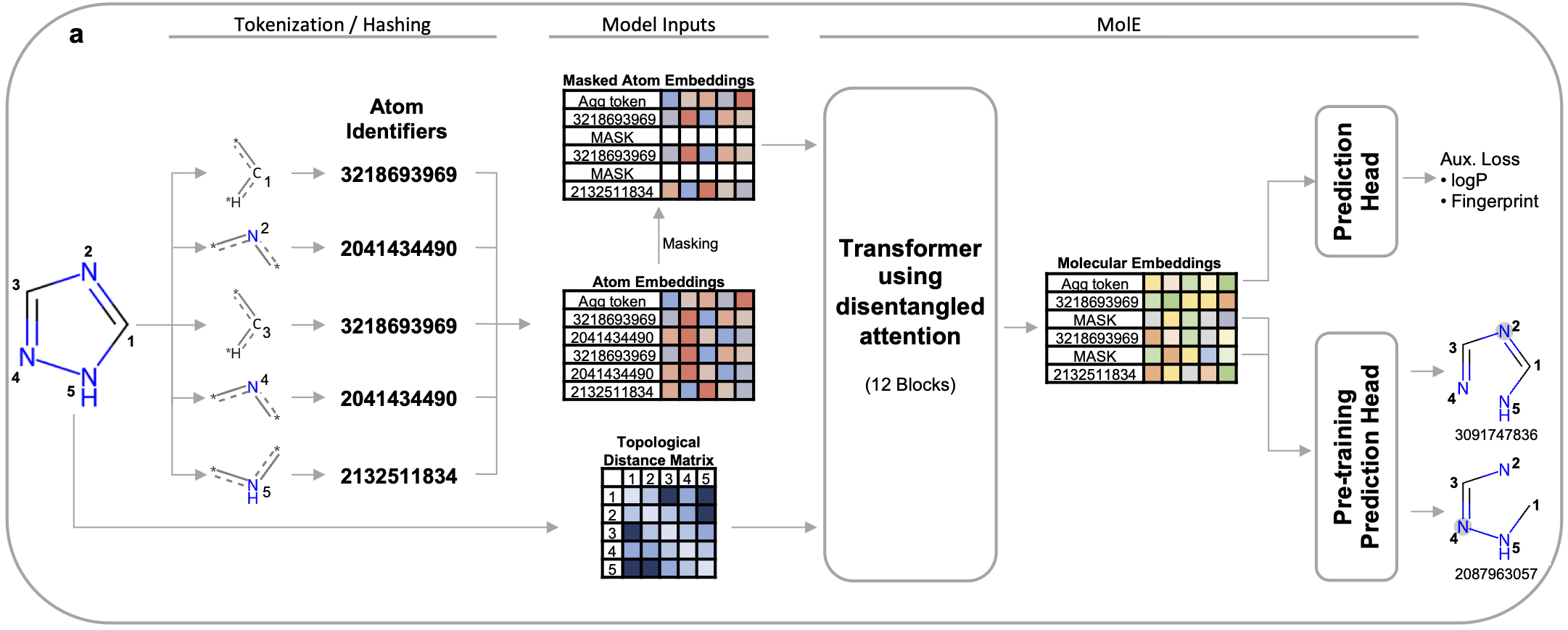Table of Contents
MolE is Recursion's foundation model for chemistry wihch combines geometric deep learning with transformers, an architecture commonly used to train Large Language Models (LLMs), to learn a meaningful representation of molecules. MolE was designed to mitigate the challenge of accurately predicting chemical properties from small public or private datasets. MolE leverages extensive labeled and unlabeled datasets in two pretraining steps. First it follows a novel self-supervised strategy using the graph representation of ~842 million molecules designed to properly learn to represent chemical structures. It is followed by a massive multi-task training to assimilate biological information.
If you want to install MolE in your local environment follow these steps:
First, create and activate your virtual environment:
# create a new virtual environment using pyenv
pyenv virtualenv mole
# activate the environment
pyenv activate moleNext, clone this repo and move into it:
git clone https://github.com/recursionpharma/mole_public.git
cd mole_publicProceed to install project dependencies, this should take less than 30 mins in a normal CPU:
# For Mac or CPU only:
pip install -r requirements/main_<PYTHON_VERSION>.txt
# For CUDA:
pip install -r requirements/main_<PYTHON_VERSION>_gpu.txt
where <PYTHON_VERSION> could be 3.9 or 3.10
Finally, install mole which should take few minutes:
pip install -e .NOTE: If you are a mac user consider to use PYTORCH_ENABLE_MPS_FALLBACK=1 as environmental variable to avoid issues between torch and M1 processors. You can do it by typing:
echo "export PYTORCH_ENABLE_MPS_FALLBACK=1" >> .bashrcTODO
Models can be easily trained usign mole_train from the command line. mole_train is powered by hydra which allows to create a configuration file and start the job .
You can always see the complete configuration file begore launching the job by adding --cfg job --resolve at the end of the command. This will print the configuration file.
If you need to fine tune MolE using a smaller dataset (e.g. to predict activity in an internal project) you can do it using mole_train model=finetune where you need to specify:
- data_file [string] - this is the path to the file containing the training set in your local computer.
- checkpoint_path [string] - this is the path to the file containing the pretrained model. If
null, training will start from a randomly initialized model - dropout [float] - specifies the dropout used in the prediction head. This should be a value between 0 and 1.
- lr [float] - sets the learning rate used during tratinig. Take into account that we used a linear warmup at the beginnig of the triaining.
Optionally you can also add information regarding:
- task [string] - this specifies if the task is a
regressionorclassificationproblem. Default: regression - num_tasks [int] - Number of tasks used. This should be same as the number of property columns in the file containing your training set. Default: 1
Example:
# Regression Example
mole_train model=finetune data_file='data/TDC_Half_Life_Obach_train_seed0.parquet' checkpoint_path=null dropout=0.1 lr=1.0e-06 task=regression num_tasks=1 model.name='MolE_Finetune_Regression' model.hyperparameters.datamodule.validation_data='data/TDC_Half_Life_Obach_valid_seed0.parquet'
# Classification Example
mole_train model=finetune data_file='data/TDC_HIA_Hou_train_seed0.csv' checkpoint_path=null dropout=0.1 lr=1.0e-06 task=classification num_tasks=1 model.name='MolE_Finetune_Classification' model.hyperparameters.datamodule.validation_data='data/TDC_HIA_Hou_valid_seed0.csv'Training data should be a csv file containing at least a column named smiles and at least one property used for training
| smiles | Property1 | Property2 |
|---|---|---|
| CCC | 301 | 283 |
| c1ccccc1 | 192 | 327 |
Once you have trained a model you can use it to predict properties of new molecules in the following way.
from mole import mole_predict
import pandas as pd
smiles= ['CCC', 'CCCCCC', 'CC', 'CCCCC'] # list of smiles
predictions = mole_predict.predict(smiles=smiles, task='regression', num_tasks=1, pretrained_model=<PATH_TO_CHECKPOINT>, batch_size=32, num_workers=4)
df = pd.DataFrame(predictions)
df.insert (0, 'smiles', smiles)
df.head()mole_predict --smiles "CCC c1ccccc1" --task regression --num_tasks 2 --pretrained_model <path to checkpoint>TO DO: predcit from smiles directly from a file
You can also compute embeddings of molecules using a pre-trained MolE model. These embeddings can be used as molecular fingerprints for model training or similarity search.
from mole import mole_predict
smiles= ['CCC', 'CCCCCC', 'CC', 'CCCCC'] # list of smiles
embeddings = mole_predict.encode(smiles=smiles, pretrained_model=<PATH_TO_CHECKPOINT>, batch_size=32, num_workers=4)
embeddings.shapeDistributed under the Attribution-NonCommercial 4.0 International License (CC-BY-NC 4.0). See LICENSE for more information.
